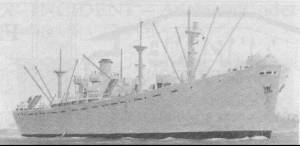- Author
- Rothery, Sortees M, Captain, RANR(S) (Ret)
- Subjects
- History - WW2
- Tags
-
- RAN Ships
- Merkur
- Publication
- July 1992 edition of the Naval Historical Review (all rights reserved)
To describe the Officers accommodation on Merkur, the cabins ran aft from the Bridge along the port side. Pilot’s cabin, Chief Officer, Second Officer and Third Officers’ cabins. A long narrow deck ran aft from the Bridge along in front of our cabins to three steps down the Sports Deck.
It was 10th November 1944, a sunny day with only a few high clouds scattered about. I was standing outside my cabin, chatting with the Third Officer, Bill Munro, our arms resting on the taffrail, casually observing other ships and activities on the harbour.
There was a light breeze coming in from the east.
Suddenly, to our surprise, what appeared to be an American Kittyhawk fighter plane streaked down the harbour from the eastern end, he was at masthead height, passing between the two lines of ships across from us, which included the Liberty Ship and the Victory Ship on the other side of her.
We remarked about this “stray”, as no other planes had been seen, nor at that time were visible or could be heard.
In the short time that we had been there, we figured that this aircraft was unusual to be amongst the ships like that.
With the roar of the aircraft passing, the Chief Officer, Bill Colquhoun stepped out from his cabin curious to see what was going on.
Our attention being drawn across on our beam to where the aircraft had just passed, on the other side of the Liberty Ship with the Victory Ship’s bow just showing beyond.
It was only a moment or two later when I saw an enormous cone like vertical flash, surmounted by a brilliant ball of fire above the Victory ship less than half a mile away. The flash was well over two hundred feet high. In the split second that followed I roared “ship blowing up”, and as the words came from my mouth we doubled up with the enormous explosion, the Chief Officer falling back into his cabin.
Grabbing at the taffrail, Bill and I pulled ourselves back up, and tried to take in what had happened. It was the Victory ship, gone, disappeared in that one huge explosion.

The Victory Ship was the ammunition ship USS Mount Hood, replaced by a thick intense concentrated dark grey to black cloud of smoke, wringing itself struggling in twists and folds as it slowly billowed vertically into a mushroom cloud up a thousand feet or more.
Every available craft on the harbour headed towards the scene where the base of the cloud was so heavy that it clung to the water with the rescue craft disappearing into it.
Aboard Merkur, the impact forced the fore-and-aft inside bulkhead of the Officers’ Cabins into the midship alleyway, Cabin curtains were sucked out through windows, apart from that, no other structural damage.
Gradually the smoke base lifted from the water revealing a sea of small craft, searching for survivors or bodies amongst the items of debris. There were no survivors.
We were horrified, standing there feeling so inadequate, all we could do was to utter “God Bless Them!’
The effect on the surrounding ships was brought to us by those visiting Merkur. The Liberty ship which sheltered us from the blast from the Mount Hood was riddled with holes, some you could drive a jeep through, with injuries aboard there too. Most debris was blown up and down the harbour to the east-west, the direction in which she was heading. Some were injured by falling debris on ships a mile up the harbour.
A special cemetery was decided on for the burial of the dead who were found. Immediately following the explosion, Kittyhawks were up there scurrying around, fanning out from the plume of smoke.
Everyone was speculating on what caused the explosion. Questions being asked, did that Kittyhawk have anything to do with it? Was that an American plane captured and being flown by a Japanese? Was it a high level bomb? Was it a torpedo, because the Boom Gate was open at the time, which prompted the obvious question, why anchor an ammunition ship in such a vulnerable position?
It was said that four hours after the explosion, “Tokyo Rose”, renowned for her propaganda on radio, said on her broadcast from Tokyo, that the credit for sinking the USS Mount Hood in Seeadler Harbour, Manus, belonged to a Japanese Midget Submarine.
How did she know? Other than that, there were many theories as to the cause of the explosion.
Two days later we had visits from two corvettes who berthed alongside for stores and water.
Our next call was Biak for a few days before returning to Brisbane.




